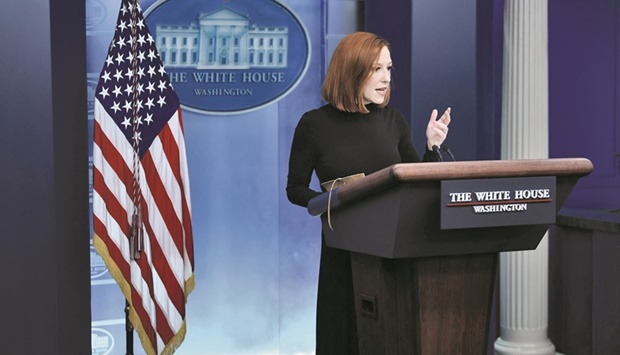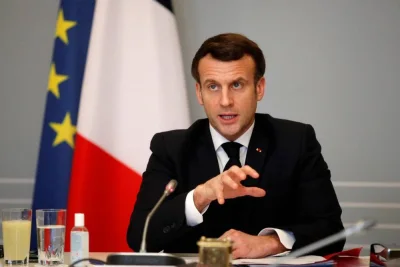• Russia retorts that such ‘destructive steps will reduce scope for political decision’
• Moscow claims Chinese support for security demands ahead of Putin-Xi meeting
President Joe Biden ordered yesterday the deployment of several thousand more troops to bolster Nato forces in eastern Europe, ratcheting up the US military response to fears that Russia could invade Ukraine.
With Russia refusing to pull back 100,000 troops poised on Ukraine’s borders, Pentagon spokesman John Kirby said 1,000 US soldiers now in Germany would deploy to Romania, and another 2,000 in the United States would be sent to Germany and Poland.
“The current situation demands that we reinforce the deterrent and defensive posture on Nato’s eastern flank,” Kirby said.
“President Biden has been clear, the United States will respond to the growing threat to Europe’s security and stability.”
Biden said yesterday his decision to deploy the troops to eastern Europe is consistent with what he has told Russian President Vladimir Putin during the standoff over Ukraine, according to reporters from CNN and Bloomberg.
The deployment, Biden told reporters as he left a White House event, is “totally consistent with what I told Putin in the beginning: As long as he is acting aggressively we’re going to make sure we can reassure our Nato allies and Eastern Europe that we’re there and Article Five is a sacred obligation,” reporters from CNN and Bloomberg said on Twitter.
In response, Russian Deputy Foreign Minister Alexander Grushko said the move would make it harder for a compromise between the two sides.
The US deployments are “destructive steps, which increase military tension and reduce scope for political decision,” he said, according to Interfax.
Kirby stressed that the deployment was to demonstrate US commitment to the Nato alliance, and that no American troops would be sent to fight in Ukraine, which is not a Nato member.
But that would hardly assuage Putin, who has accused the US and Nato of seeking to “contain” Russia by placing troops and strategic arms on its border.
“Ukraine itself is just a tool to achieve this goal,” Putin said Tuesday in his first major comments in weeks on the crisis.
Putin has demanded guarantees that Ukraine will not join the alliance, and has implicitly threatened the former Soviet state with the massive military buildup.
Russia also wants Nato and the United States to foreswear the deployment of missile systems near Russia’s borders and to pull back Nato forces in eastern Europe.
Putin has left the door open to talks, saying he was studying Western proposals and that he hoped that “in the end we will find a solution.”
But in a phone call with British Prime Minister Boris Johnson yesterday he also noted “the unwillingness of Nato to adequately respond to the well-founded Russian concerns,” the Kremlin said in a statement — though Downing Street added that both leaders agreed on the need for a “peaceful outcome.”
The Kremlin also said it had Beijing’s support in the standoff, and that would emerge when Putin meets Chinese leader Xi Jinping in Beijing tomorrow.
“A joint statement on international relations entering a new era has been prepared for the talks,” the Kremlin’s top foreign policy adviser Yury Ushakov told reporters, adding that it will reflect Moscow and Beijing’s “common views” on security among other issues.
“China supports Russia’s demands for security guarantees,” Ushakov added.
Poland and Romania both said they appreciated the US move.
Dutch Prime Minister Mark Rutte was the latest Nato leader to visit Kyiv in a show of support for Ukraine, where he met President Volodymyr Zelensky.
After the talks, Zelensky said Ukraine was focused “only on peace”, but insisted it has the right to defend itself. Rutte said it was “essential for dialogue to continue” between Russia and the other players.
Citing leaked documents, the Spanish newspaper El Pais reported that Western proposals to Russia include arms control and trust-building measures to defuse the situation.
While a guarantee against Ukraine joining Nato was not offered, the documents proposed “reciprocal commitments” by the US and Russia “to refrain from deploying offensive ground-launched missile systems and permanent forces with a combat mission in the territory of Ukraine,” El Pais reported.
“We did not make this document public,” Kirby said.
Nevertheless, he said, it confirms that “Nato and its partners are unified in their resolve and open to constructive and serious diplomacy.”
White House Press Secretary Jen Psaki said Biden’s order was the result of several weeks of talks with partners, and not the reaction to anything specific in the past two days.
“It’s not permanent,” she said of the deployment.
“Obviously if Russia decides to deescalate ... then certainly that would impact the force posture,” she said.
But Kirby said Moscow has shown “no signs of being interested or willing to de-escalate.”
“Mr. Putin continues to add forces, combined arms, offensive capabilities, even over just the last 24 hours. He continues to add in western Russia and Belarus and ... the Mediterranean and the North Atlantic.”
Nato welcomed the new US troop deployment, with Secretary-General Jens Stoltenberg saying “Nato will do whatever is necessary to protect and defend all allies.”

White House Press Secretary Jen Psaki speaks during the daily press briefing at the White House yesterday in Washington, DC. (AFP)


